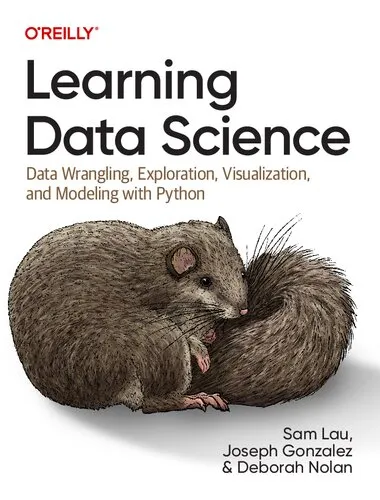Learning Data Science: Data Wrangling, Exploration, Visualization, and Modeling with Python
5.0
بر اساس نظر کاربران

شما میتونید سوالاتتون در باره کتاب رو از هوش مصنوعیش بعد از ورود بپرسید
هر دانلود یا پرسش از هوش مصنوعی 2 امتیاز لازم دارد، برای بدست آوردن امتیاز رایگان، به صفحه ی راهنمای امتیازات سر بزنید و یک سری کار ارزشمند انجام بدینمعرفی کتاب "Learning Data Science: Data Wrangling, Exploration, Visualization, and Modeling with Python"
کتاب "Learning Data Science: Data Wrangling, Exploration, Visualization, and Modeling with Python" راهنمایی جامع و کاربردی برای ورود به دنیای علم داده (Data Science) است. این کتاب توسط سم لاو، جوزف گونزالس، و دبرا نولان نوشته شده و تمرکز آن بر آموزش اصول اولیه، فنون پیشرفته و ابزارهای کلیدی علم داده با استفاده از زبان برنامهنویسی قدرتمند Python است. با این کتاب، شما نه تنها مفاهیم پایه را فرا خواهید گرفت، بلکه مهارتهای عملی برای آمادهسازی و تحلیل دادهها را نیز کسب خواهید کرد.
خلاصه ای از کتاب
این کتاب در چهار بخش اصلی تنظیم شده است:
- ۱. Data Wrangling: روشهای پاکسازی و آمادهسازی دادهها برای تحلیل.
- ۲. Exploration: ابزارهایی برای کشف الگوها و روندها در دادهها.
- ۳. Visualization: ایجاد نمودارها و گرافهای حرفهای برای تفهیم بهتر اطلاعات.
- ۴. Modeling: ساخت مدلهای پیشبینیکننده و تحلیلهای آماری پیچیده.
در طول این کتاب، روشهای عملی و پروژههای واقعی، خوانندگان را قادر میسازد که اصول علم داده را به سرعت فراگیرند و به صورت عملی در پروژههای حرفهای خود به کار برند. نوشتار ساده و مثالهای قابل فهم، این کتاب را به یکی از بهترین منابع برای دانشجویان و متخصصان علم داده تبدیل کرده است.
درسهای کلیدی این کتاب
- تسلط کامل بر دستورات ضروری Python برای علم داده.
- آشنایی با ابزارهای مهم مانند Pandas، NumPy، و Matplotlib.
- ایجاد مدلهای پیشرفته Machine Learning با استفاده از scikit-learn.
- یادگیری مفاهیم آماری و نحوه استفاده عملی از آنها.
- بهینهسازی و تمیز کردن دادهها برای ایجاد تحلیلهای دقیقتر.
جملات معروف کتاب
"علم داده، ترکیبی است از هنر و علم؛ هنر یافتن بصیرتها و علم مدلسازی." - از نویسندگان کتاب
"دادهها ستون اصلی تصمیمگیریهای مدرن هستند. توانایی مدیریت و تحلیل دادهها، یک مهارت حیاتی در جهان امروز محسوب میشود."
چرا این کتاب مهم است؟
در عصر انفجار اطلاعات، علم داده یکی از ضروریترین تخصصها برای افراد در هر صنعت است. این کتاب به دلیل ساختار سازماندهی شده، محتواهای جامع، و تمرکز بر استفاده عملی از Python، یکی از منابع ارزشمند برای متخصصان و علاقهمندان به حوزه علم داده محسوب میشود. نویسندگان این کتاب، با تاکید بر یادگیری مبتنی بر پروژه و اصول کاربردی، به خوانندگان کمک میکنند تا این مهارت را با اعتماد به نفس بیشتر و کارایی بالاتر فرا گیرند.
همچنین، این کتاب نه تنها مناسب افراد مبتدی، بلکه برای متخصصان حرفهای که به دنبال بهبود توانمندیها و توسعه دانش خود در حوزه علم داده هستند، یک منبع الهامبخش است.
Introduction to "Learning Data Science: Data Wrangling, Exploration, Visualization, and Modeling with Python"
Data science has become one of the most transformative disciplines in recent years, shaping the decisions of individuals, organizations, and governments alike. With the increasing demand for skilled professionals who can harness the power of data, "Learning Data Science" serves as a comprehensive guide for anyone looking to enter or advance in this dynamic field. Written by Sam Lau, Joseph Gonzalez, and Deborah Nolan, this book combines practical techniques, theoretical insights, and hands-on examples to help readers navigate the entire data science workflow. Built on Python's powerful ecosystem, it equips learners with tools and methods to uncover insights from data, make informed decisions, and communicate their findings effectively.
Detailed Summary of the Book
At its core, "Learning Data Science" provides a structured approach to mastering the essential skills of a modern data scientist. The book is divided into logical sections, each focusing on specific phases of the data science process. Starting with data wrangling, readers will learn how to clean, transform, and organize raw data into a form suitable for analysis. This foundational step sets the stage for impactful exploration and visualization, which are crucial for identifying patterns and trends.
Subsequent chapters delve into statistical modeling and machine learning, offering a robust introduction to predictive modeling techniques. Practical examples are combined with theoretical explanations, ensuring that readers grasp the "why" behind the methods they use. The authors skillfully weave together programming, mathematics, and domain expertise, presenting Python as a user-friendly yet powerful tool to achieve objectives within the data science workflow. Along the way, the book emphasizes good coding practices, reproducibility, and critical thinking—all essential traits for effective data scientists.
Advanced topics such as evaluating model performance, working with big data, and ethical considerations in data science are covered as well. The book's clear writing, carefully structured exercises, and Python code snippets make it accessible to both beginners and experienced professionals seeking to refresh their knowledge or learn the latest techniques.
Key Takeaways
- Learn the entire data science workflow from start to finish, including data wrangling, exploration, visualization, and modeling.
- Master Python programming for data science, utilizing libraries like pandas, NumPy, Matplotlib, and scikit-learn.
- Understand statistical principles and machine learning models that drive decision-making and predictions.
- Engage with hands-on practice using real-world data sets for a practical, application-driven learning experience.
- Explore ethical considerations and responsible practices in data science projects.
- Develop skills for communicating insights effectively to stakeholders using visual tools and storytelling techniques.
Famous Quotes from the Book
"Data science is not just about numbers; it's about turning numbers into stories that drive impactful decisions."
"The magic of data science lies in its ability to reveal invisible patterns—the clues hidden beneath the surface of information."
"Good data scientists are not just coders—they are detectives, explorers, and storytellers rolled into one."
Why This Book Matters
The importance of "Learning Data Science" extends beyond its utility as a technical guide. In a world increasingly driven by data, professionals who understand how to extract meaning and value from information are more critical than ever. This book empowers readers with the fundamental skills needed to thrive in data-intensive environments, bridging the gap between technical expertise and practical application.
Additionally, the authors recognize that data science is not just about technical mastery but also about ethical considerations and effective communication. By incorporating discussions on biases, fairness, and transparency, they ensure that readers approach data analysis responsibly and thoughtfully. The emphasis on storytelling and visualization further highlights the importance of translating technical findings into actionable insights for diverse audiences.
Whether you're an aspiring data scientist, an analyst seeking to sharpen your skills, or a seasoned professional looking to stay updated, "Learning Data Science" provides the knowledge, tools, and inspiration needed to achieve your goals. Its combination of rigor, accessibility, and relevancy makes it a cornerstone resource in the rapidly evolving field of data science.
دانلود رایگان مستقیم
You Can Download this book after Login
دسترسی به کتابها از طریق پلتفرمهای قانونی و کتابخانههای عمومی نه تنها از حقوق نویسندگان و ناشران حمایت میکند، بلکه به پایداری فرهنگ کتابخوانی نیز کمک میرساند. پیش از دانلود، لحظهای به بررسی این گزینهها فکر کنید.
این کتاب رو در پلتفرم های دیگه ببینید
WorldCat به شما کمک میکنه تا کتاب ها رو در کتابخانه های سراسر دنیا پیدا کنید
امتیازها، نظرات تخصصی و صحبت ها درباره کتاب را در Goodreads ببینید
کتابهای کمیاب یا دست دوم را در AbeBooks پیدا کنید و بخرید
1160
بازدید5.0
امتیاز51
نظر98%
رضایتنظرات:
5.0
بر اساس 1 نظر کاربران
"کیفیت چاپ عالی بود، خیلی راضیام"
nandan0
7 ژون 2025، ساعت 6:27
This book really nails the data exploration concepts that are so key for sound analysis and are usually overlooked. The list of semi-automated packages for data exploration/treatment is not exhaustive given that the list of new tools are always expanding.


